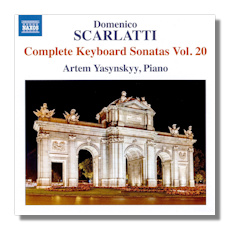
The Internet's Premier Classical Music Source
Related Links
- Scarlatti Reviews
- Latest Reviews
- More Reviews
-
By Composer
-
Collections
DVD & Blu-ray
Books
Concert Reviews
Articles/Interviews
Software
Audio
Search Amazon
Recommended Links
Site News
 CD Review
CD Review
Domenico Scarlatti

Complete Keyboard Sonatas, Volume 20
- Sonata in B Flat Major, K.503/L.196/P.447
- Sonata in G Minor, K.315/L.235/P.54
- Sonata in G Major, K.539/L.121/P.543
- Sonata in E Major, K.530/L.44/P.534
- Sonata in C Major, K.385/L.284/P.220
- Sonata in F Major, K.379/L.73/P.107
- Sonata in D Minor, K.396/L.110/P.435
- Sonata in C Major, K.513/L.Supp.3/P.176
- Sonata in F Sharp Major, K.319/L.35/P.303
- Sonata in D Major, K.358/L.412/P.457
- Sonata in E Major, K.495/L.426/P.384
- Sonata in A Major, K.301/L.493/P.361
- Sonata in D Major, K.346/L.60/P.250
- Sonata in G Major, K.520/L.86/P.362
- Sonata in C Major, K.460/L.324/P.378
- Sonata in G Major, K.413/L.125/P.416
- Sonata in G Major, K.431/L.365/P.83
- Sonata in D Major, K.484/L.419/P.428
Artem Yasynskyy, piano
Naxos 8.573604 58:55
This massive Naxos project to record all 555 sonatas of Domenico Scarlatti has involved quite a large array of pianists, apparently to get a variety of interpretive styles. You might surmise that the label chose to use numerous players primarily to complete the undertaking sooner, but in checking back I noticed that the first two volumes were released in 1999. Scott Ross famously recorded all the sonatas in 1984-85 for Erato. So things are proceeding rather slowly in this Naxos project. Moreover, if the label had chosen a single pianist for the job, it might have been risky if that performer had a limited or controversial interpretive view of the music. In the end, choosing the path that Naxos has selected is safer and, for the listener, much more interesting, if not completely adventurous.
I have previously covered a half-dozen discs in this series, though I have thirteen in my collection. I have found that all but one or two are worthy of attention. I began coverage with volume 3, featuring pianist Jenő Jandó (Naxos 8.555047). Along the way I have also written notices on quite a few other recordings that are not a part of this Scarlatti series and my overall impression of all the discs is this: pianists who play with a lean tone, light touch, narrow range of dynamics, sparing rubato, lively tempos, and very limited use of the pedal generally play this music well. The fact that Scarlatti was writing the sonatas for harpsichord (or fortepiano) explains the need for a typically scaled-down approach.
In this newest Naxos volume pianist Artem Yasynskyy pretty much follows this interpretive formula, but with the highest skill, the most sensitive artistry. In fact, after listening to his performances, I can say that if Naxos had wanted a single pianist for the project, he might well have been a top choice. He is that impressive. The only other truly formidable competition for that honor who comes to mind is Claire Huangci, who recorded two discs of Scarlatti sonatas for Berlin Classics, which I reviewed here in 2015 (0300603BC ). Yasynskyy seems to have a nearly perfect style for Scarlatti: beside displaying all the qualities cited above, he has an interpretive intelligence that seems to guide him in every performance here. Everything sounds natural and convincing, as if the music can hardly be played another way. Even seemingly minor details are rendered with the greatest care: Yasynskyy's trills, for example, are light, feathery, and elegant, perfectly fitting Scarlatti's Baroque style.
The opening B Flat Major Sonata (K.503) sparkles with such effervescence and joy, the rhythms steady and bouncy, full of energy and spirit. Right now, I can't imagine a better performance. In the G Major Sonata (K. 539; track 3) I marveled at Yasynskyy's ability to make the most of the trills and those rapid-fire ascending chords. These little Scarlattian touches might sound like cute but gimcrack dressing in the hands of another pianist, but here they add a subtle dimension to the music. Listen to the gentle wistfulness in the main theme of the C Major Sonata (K. 513; track 8), and then notice how Yasynskyy, for contrast, deftly infuses the alternate material with an almost exaggerated sense of confidence and pride. The Presto section at the end is breathlessly paced and an utter joy to hear. Try track 11, which features the E Major Sonata (K. 495), and notice the infectious spirit, the elegance in the pianist's incredible digital dexterity. The G Major Sonata (K. 520; track 14) is another gem: listen to how the pianist seems to enact all sorts of laughter and fun in one of the most joyous Scarlattian romps you'll ever hear.
I could go on citing additional examples of Yasynskyy's remarkable skills and insights here, but I think you've gotten the message. Now, you're wondering, just who is Artem Yasynskyy? He is a Ukrainian-born pianist who was a child prodigy on the piano and who later became a student of Patrick O'Byrne at the University of Arts in Bremen. He has been a prizewinner in several major competitions and clearly demonstrates here that those who don't win the competition are sometimes better than those who do. Ironically, the same can be said of the other extraordinary pianist I mentioned here, Claire Huangci. More often than not I'll take the second- and third-prize winners in competitions, at least certain ones, and you can have the winners. My advice to Naxos is, latch onto Yasynskyy and engage him to do more recordings in this series as well as other repertory from Chopin, Liszt, Prokofiev and others.
At any rate, the sound reproduction provided by Naxos is splendid, and I must say that the piano used by Yasynskyy is perfect for these sonatas. Keith Anderson's notes are, as usual, a very helpful addition. Urgently recommended.
Copyright © 2018, Robert Cummings


















